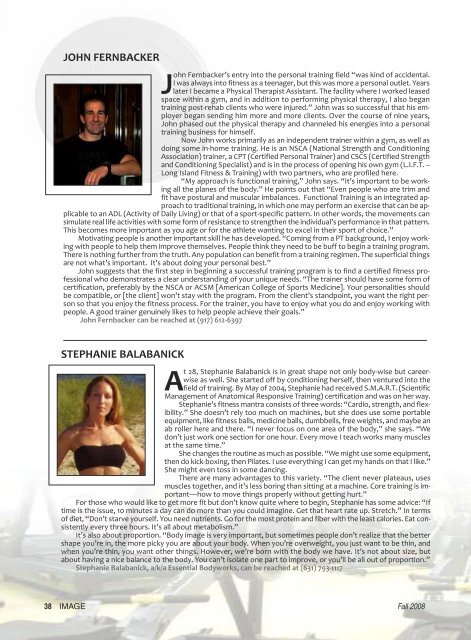TEEN KUTZ
TEEN KUTZ
TEEN KUTZ
You also want an ePaper? Increase the reach of your titles
YUMPU automatically turns print PDFs into web optimized ePapers that Google loves.
John fernbAcker<br />
J ohn<br />
Fernbacker’s entry into the personal training field “was kind of accidental.<br />
I was always into fitness as a teenager, but this was more a personal outlet. Years<br />
later I became a Physical Therapist Assistant. The facility where I worked leased<br />
space within a gym, and in addition to performing physical therapy, I also began<br />
training post-rehab clients who were injured.” John was so successful that his employer<br />
began sending him more and more clients. Over the course of nine years,<br />
John phased out the physical therapy and channeled his energies into a personal<br />
training business for himself.<br />
Now John works primarily as an independent trainer within a gym, as well as<br />
doing some in-home training. He is an NSCA (National Strength and Conditioning<br />
Association) trainer, a CPT (Certified Personal Trainer) and CSCS (Certified Strength<br />
and Conditioning Specialist) and is in the process of opening his own gym (L.I.F.T. –<br />
Long Island Fitness & Training) with two partners, who are profiled here.<br />
“My approach is functional training,” John says. “It’s important to be working<br />
all the planes of the body.” He points out that “even people who are trim and<br />
fit have postural and muscular imbalances. Functional Training is an integrated approach<br />
to traditional training, in which one may perform an exercise that can be applicable<br />
to an ADL (Activity of Daily Living) or that of a sport-specific pattern. In other words, the movements can<br />
simulate real life activities with some form of resistance to strengthen the individual’s performance in that pattern.<br />
This becomes more important as you age or for the athlete wanting to excel in their sport of choice.”<br />
Motivating people is another important skill he has developed. “Coming from a PT background, I enjoy working<br />
with people to help them improve themselves. People think they need to be buff to begin a training program.<br />
There is nothing further from the truth. Any population can benefit from a training regimen. The superficial things<br />
are not what’s important. It’s about doing your personal best.”<br />
John suggests that the first step in beginning a successful training program is to find a certified fitness professional<br />
who demonstrates a clear understanding of your unique needs. “The trainer should have some form of<br />
certification, preferably by the NSCA or ACSM [American College of Sports Medicine]. Your personalities should<br />
be compatible, or [the client] won’t stay with the program. From the client’s standpoint, you want the right person<br />
so that you enjoy the fitness process. For the trainer, you have to enjoy what you do and enjoy working with<br />
people. A good trainer genuinely likes to help people achieve their goals.”<br />
John fernbacker can be reached at (917) 612-6397<br />
stephAnie bAlAbAnick<br />
A t<br />
28, Stephanie Balabanick is in great shape not only body-wise but careerwise<br />
as well. She started off by conditioning herself, then ventured into the<br />
field of training. By May of 2004, Stephanie had received S.M.A.r.T. (Scientific<br />
Management of Anatomical responsive Training) certification and was on her way.<br />
Stephanie’s fitness mantra consists of three words: “Cardio, strength, and flexibility.”<br />
She doesn’t rely too much on machines, but she does use some portable<br />
equipment, like fitness balls, medicine balls, dumbbells, free weights, and maybe an<br />
ab roller here and there. “I never focus on one area of the body,” she says. “We<br />
don’t just work one section for one hour. every move I teach works many muscles<br />
at the same time.”<br />
She changes the routine as much as possible. “We might use some equipment,<br />
then do kick-boxing, then Pilates. I use everything I can get my hands on that I like.”<br />
She might even toss in some dancing.<br />
There are many advantages to this variety. “The client never plateaus, uses<br />
muscles together, and it’s less boring than sitting at a machine. Core training is important—how<br />
to move things properly without getting hurt.”<br />
For those who would like to get more fit but don’t know quite where to begin, Stephanie has some advice: “If<br />
time is the issue, 10 minutes a day can do more than you could imagine. Get that heart rate up. Stretch.” In terms<br />
of diet, “Don’t starve yourself. You need nutrients. Go for the most protein and fiber with the least calories. eat consistently<br />
every three hours. It’s all about metabolism.”<br />
It’s also about proportion. “Body image is very important, but sometimes people don’t realize that the better<br />
shape you’re in, the more picky you are about your body. When you’re overweight, you just want to be thin, and<br />
when you’re thin, you want other things. However, we’re born with the body we have. It’s not about size, but<br />
about having a nice balance to the body. You can’t isolate one part to improve, or you’ll be all out of proportion.”<br />
stephanie balabanick, a/k/a essential bodyworks, can be reached at (631) 793-1117<br />
38 IMAGE Fall 2008


